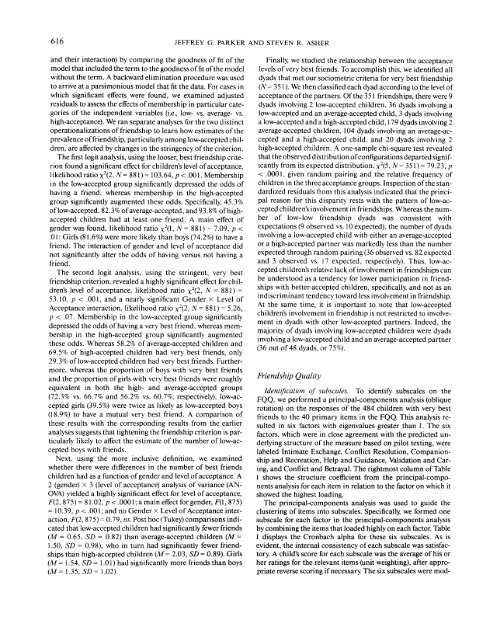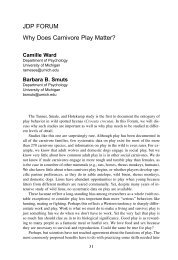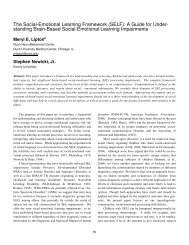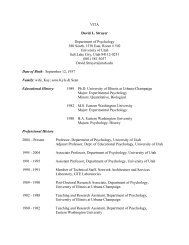Friendship and Friendship Quality in Middle Childhood ... - Psychology
Friendship and Friendship Quality in Middle Childhood ... - Psychology
Friendship and Friendship Quality in Middle Childhood ... - Psychology
You also want an ePaper? Increase the reach of your titles
YUMPU automatically turns print PDFs into web optimized ePapers that Google loves.
616 JEFFREY G. PARKER AND STEVEN R. ASHER<br />
<strong>and</strong> their <strong>in</strong>teraction) by compar<strong>in</strong>g the goodness of fit of the<br />
model that <strong>in</strong>cluded the term to the goodness of fit of the model<br />
without the term. A backward elim<strong>in</strong>ation procedure was used<br />
to arrive at a parsimonious model that fit the data. For cases <strong>in</strong><br />
which significant effects were found, we exam<strong>in</strong>ed adjusted<br />
residuals to assess the effects of membership <strong>in</strong> particular categories<br />
of the <strong>in</strong>dependent variables (i.e., low- vs. average- vs.<br />
high-acceptance). We ran separate analyses for the two dist<strong>in</strong>ct<br />
operationalizations of friendship to learn how estimates of the<br />
prevalence of friendship, particularly among low-accepted children,<br />
are affected by changes <strong>in</strong> the str<strong>in</strong>gency of the criterion.<br />
The first logit analysis, us<strong>in</strong>g the looser, best friendship criterion<br />
found a significant effect for children's level of acceptance,<br />
likelihood ratio x 2 (2, N= 881) = 103.64, p< .001. Membership<br />
<strong>in</strong> the low-accepted group significantly depressed the odds of<br />
hav<strong>in</strong>g a friend, whereas membership <strong>in</strong> the high-accepted<br />
group significantly augmented these odds. Specifically, 45.3%<br />
of low-accepted, 82.3% of average-accepted, <strong>and</strong> 93.8% of highaccepted<br />
children had at least one friend. A ma<strong>in</strong> effect of<br />
gender was found, likelihood ratio x 2 (L N = 881) = 7.09, p <<br />
.01: Girls (81.6%) were more likely than boys (74.2%) to have a<br />
friend. The <strong>in</strong>teraction of gender <strong>and</strong> level of acceptance did<br />
not significantly alter the odds of hav<strong>in</strong>g versus not hav<strong>in</strong>g a<br />
friend.<br />
The second logit analysis, us<strong>in</strong>g the str<strong>in</strong>gent, very best<br />
friendship criterion, revealed a highly significant effect for children's<br />
level of acceptance, likelihood ratio x 2 (2, N = 881) =<br />
53.10, p < .001, <strong>and</strong> a nearly significant Gender X Level of<br />
Acceptance <strong>in</strong>teraction, likelihood ratio x 2 (2, N= 881) = 5.26,<br />
p < .07. Membership <strong>in</strong> the low-accepted group significantly<br />
depressed the odds of hav<strong>in</strong>g a very best friend, whereas membership<br />
<strong>in</strong> the high-accepted group significantly augmented<br />
these odds. Whereas 58.27o of average-accepted children <strong>and</strong><br />
69.5% of high-accepted children had very best friends, only<br />
29.3% of low-accepted children had very best friends. Furthermore,<br />
whereas the proportion of boys with very best friends<br />
<strong>and</strong> the proportion of girls with very best friends were roughly<br />
equivalent <strong>in</strong> both the high- <strong>and</strong> average-accepted groups<br />
(72.3% vs. 66.7% <strong>and</strong> 56.2% vs. 60.7%, respectively), low-accepted<br />
girls (39.5%) were twice as likely as low-accepted boys<br />
(18.9%) to have a mutual very best friend. A comparison of<br />
these results with the correspond<strong>in</strong>g results from the earlier<br />
analyses suggests that tighten<strong>in</strong>g the friendship criterion is particularly<br />
likely to affect the estimate of the number of low-accepted<br />
boys with friends.<br />
Next, us<strong>in</strong>g the more <strong>in</strong>clusive def<strong>in</strong>ition, we exam<strong>in</strong>ed<br />
whether there were differences <strong>in</strong> the number of best friends<br />
children had as a function of gender <strong>and</strong> level of acceptance. A<br />
2 (gender) X 3 (level of acceptance) analysis of variance (AN-<br />
OVA) yielded a highly significant effect for level of acceptance,<br />
F(2,875) = 81.02, p < .0001; a ma<strong>in</strong> effect for gender, F(l ,875)<br />
= 10.39, p < .001; <strong>and</strong> no Gender X Level of Acceptance <strong>in</strong>teraction,<br />
F(2,875) = 0.79, ns. Post hoc (Tukey) comparisons <strong>in</strong>dicated<br />
that low-accepted children had significantly fewer friends<br />
(M = 0.65, SD = 0.82) than average-accepted children (M =<br />
1.50, SD = 0.98), who <strong>in</strong> turn had significantly fewer friendships<br />
than high-accepted children (M= 2.03, SD = 0.89). Girls<br />
(M = 1.54, SD = 1.01) had significantly more friends than boys<br />
(M= 1.35, SD= 1.02).<br />
F<strong>in</strong>ally, we studied the relationship between the acceptance<br />
levels of very best friends. To accomplish this, we identified all<br />
dyads that met our sociometric criteria for very best friendship<br />
(A r = 351). We then classified each dyad accord<strong>in</strong>g to the level of<br />
acceptance of the partners. Of the 351 friendships, there were 9<br />
dyads <strong>in</strong>volv<strong>in</strong>g 2 low-accepted children, 36 dyads <strong>in</strong>volv<strong>in</strong>g a<br />
low-accepted <strong>and</strong> an average-accepted child, 3 dyads <strong>in</strong>volv<strong>in</strong>g<br />
a low-accepted <strong>and</strong> a high-accepted child, 179 dyads <strong>in</strong>volv<strong>in</strong>g 2<br />
average-accepted children, 104 dyads <strong>in</strong>volv<strong>in</strong>g an average-accepted<br />
<strong>and</strong> a high-accepted child, <strong>and</strong> 20 dyads <strong>in</strong>volv<strong>in</strong>g 2<br />
high-accepted children. A one-sample chi-square test revealed<br />
that the observed distribution of configurations departed significantly<br />
from its expected distribution, x 2 (5, N= 351)= 79.23, p<br />
< .0001, given r<strong>and</strong>om pair<strong>in</strong>g <strong>and</strong> the relative frequency of<br />
children <strong>in</strong> the three acceptance groups. Inspection of the st<strong>and</strong>ardized<br />
residuals from this analysis <strong>in</strong>dicated that the pr<strong>in</strong>cipal<br />
reason for this disparity rests with the pattern of low-accepted<br />
children's <strong>in</strong>volvement <strong>in</strong> friendships. Whereas the number<br />
of low-low friendship dyads was consistent with<br />
expectations (9 observed vs. 10 expected), the number of dyads<br />
<strong>in</strong>volv<strong>in</strong>g a low-accepted child with either an average-accepted<br />
or a high-accepted partner was markedly less than the number<br />
expected through r<strong>and</strong>om pair<strong>in</strong>g (36 observed vs. 82 expected<br />
<strong>and</strong> 3 observed vs. 17 expected, respectively). Thus, low-accepted<br />
children's relative lack of <strong>in</strong>volvement <strong>in</strong> friendships can<br />
be understood as a tendency for lower participation <strong>in</strong> friendships<br />
with better-accepted children, specifically, <strong>and</strong> not as an<br />
<strong>in</strong>discrim<strong>in</strong>ant tendency toward less <strong>in</strong>volvement <strong>in</strong> friendship.<br />
At the same time, it is important to note that low-accepted<br />
children's <strong>in</strong>volvement <strong>in</strong> friendship is not restricted to <strong>in</strong>volvement<br />
<strong>in</strong> dyads with other low-accepted partners. Indeed, the<br />
majority of dyads <strong>in</strong>volv<strong>in</strong>g low-accepted children were dyads<br />
<strong>in</strong>volv<strong>in</strong>g a low-accepted child <strong>and</strong> an average-accepted partner<br />
(36 out of 48 dyads, or 75%).<br />
<strong>Friendship</strong> <strong>Quality</strong><br />
Identification of subscales. To identify subscales on the<br />
FQQ, we performed a pr<strong>in</strong>cipal-components analysis (oblique<br />
rotation) on the responses of the 484 children with very best<br />
friends to the 40 primary items <strong>in</strong> the FQQ. This analysis resulted<br />
<strong>in</strong> six factors with eigenvalues greater than 1. The six<br />
factors, which were <strong>in</strong> close agreement with the predicted underly<strong>in</strong>g<br />
structure of the measure based on pilot test<strong>in</strong>g, were<br />
labeled Intimate Exchange, Conflict Resolution, Companionship<br />
<strong>and</strong> Recreation, Help <strong>and</strong> Guidance, Validation <strong>and</strong> Car<strong>in</strong>g,<br />
<strong>and</strong> Conflict <strong>and</strong> Betrayal. The rightmost column of Table<br />
1 shows the structure coefficient from the pr<strong>in</strong>cipal-components<br />
analysis for each item <strong>in</strong> relation to the factor on which it<br />
showed the highest load<strong>in</strong>g.<br />
The pr<strong>in</strong>cipal-components analysis was used to guide the<br />
cluster<strong>in</strong>g of items <strong>in</strong>to subscales. Specifically, we formed one<br />
subscale for each factor <strong>in</strong> the pr<strong>in</strong>cipal-components analysis<br />
by comb<strong>in</strong><strong>in</strong>g the items that loaded highly on each factor. Table<br />
1 displays the Cronbach alpha for these six subscales. As is<br />
evident, the <strong>in</strong>ternal consistency of each subscale was satisfactory.<br />
A child's score for each subscale was the average of his or<br />
her rat<strong>in</strong>gs for the relevant items (unit weight<strong>in</strong>g), after appropriate<br />
reverse scor<strong>in</strong>g if necessary. The six subscales were mod-





